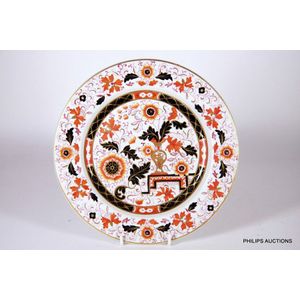Victorian Imari Ironstone Plate, 1875
You must be a subscriber, and be logged in to view price and dealer details.
Subscribe Now to view actual auction price for this item
When you subscribe, you have the option of setting the currency in which to display prices to $Au, $US, $NZ or Stg.
- Victorian Period - The Victorian period of furniture and decorative arts design covers the reign of Queen Victoria from 1837 to 1901. There was not one dominant style of furniture in the Victorian period. Designers used and modified many historical styles such as Gothic, Tudor, Elizabethan, English Rococo, Neoclassical and others, although use of some styles, such as English Rococo and Gothic tended to dominate the furniture manufacture of the period.
The Victorian period was preceded by the Regency and William IV periods, and followed by the Edwardian period, named for Edward VII (1841 ? 1910) who was King of the United Kingdom and the British Dominions and Emperor of India for the brief period from 1901 until his death in 1910. - Circa - A Latin term meaning 'about', often used in the antique trade to give an approximate date for the piece, usually considered to be five years on either side of the circa year. Thus, circa 1900 means the piece was made about 1900, probably between 1895 and 1905. The expression is sometimes abbreviated to c.1900.
- Ironstone China - Credit for the invention of ironstone china is generally accorded to Charles Mason in 1813. Charles Mason was one of the two sons of Miles Mason who founded the Mason works in 1802, and ran the business with his brother George Mason.
Ironstone was a heavy hard earthenware which was slightly translucent, its strength supposedly coming from a very small quantity of iron slag added to the mixture. The additional strength enabled the company to make larger objects that were not susceptible to breakage.
The company manufactured dinner wares, toilet sets, tureens, jugs and so on, and the most popular patterns were blue and white, floral and Oriental Imari style colours.
The trade name "Patent Ironstone China" was registered by the company in 1813, but the patent was only valid for 14 years and was not renewed, enabling other potteries to use the word "ironstone" in describing their wares.
Mason wares are generally well marked with "Mason's Patent Ironstone China" .
This item has been included into following indexes:
Visually similar items

Late 18th century Worcester Queen Charlotte plate, diameter 19.5 cm (restored chip to back)

Japanese Imari plate, probably 17th/18th century.diameter 22.5 cm

A large Japanese Imari dish, Meiji period, decorated with panels of phoenix and long tailed birds on blossoming sprays, impressed mark to the base, diameter 30 cm

A Crown Derby 'Chrysanthemums' cabinet plate 1877-1890, pattern 198. In the Japanese Imari taste in cobalt, iron red, apple green colours with gilt enrichments upon a lemon ground, with chrysanthemums and shaped cartouches centrally, vegetal and patterned
